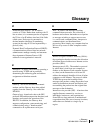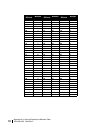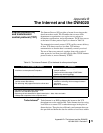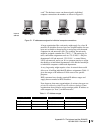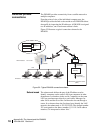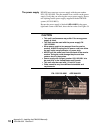
Appendix B • The Internet and the DW4020
1031484-0001 Revision 2
71
Appendix B
The Internet and the DW4020
Internet protocol (IP)
and transmission
control protocol (TCP)
The Internet Protocol (IP) provides a format for moving packet
data from node to node. The IP enables data to move from
department to organization, to a region, across regions, to
destination organizations, and to departments. The IP layer serves
as the basis for other protocol layers, as shown in Table 10.
The transmission control protocol (TCP) verifies correct delivery
of data. TCP detects errors or lost data. TCP initiates
retransmission so that the data is eventually correctly received.
The use of these two protocols, together along with a suite of
other protocols, has been given the official name TCP/IP internet
protocol suite, or, more commonly TCP/IP.
Turbo Intranet
™
Turbo Intranet is an HNS technique that increases the TCP
throughput across the satellite link. Turbo Intranet involves using
local devices to answer TCP overhead messages in the place of
distant devices. These devices efficiently send outroute data over
the spacelink and buffer the data for transfer to local hosts within
Table 10: The Internet Protocol (IP) is the basis for other protocol layers
FTP – File Transfer Protocol IP – multicast
• Reliable method for delivering files from a host
machine to remote personal computers
• Universal way to broadcast digital content to
multiple locations
• Takes maximum advantage of DIRECWAY
satellite star network topology
TCP – Transmission Control Protocol UDP – User Datagram Protocol
• Session oriented protocol
verifies correct data delivery
• For delivering web pages and mission critical data
• Datagram oriented protocol
method for delivering short messages between
two points
• Basis of IP-multicast
IP – Internet Protocol
• Format for moving data from node to node
• Basis for all of the above protocols
• Becoming de facto standard for digital transmission – data, video and audio
• Widespread acceptance in the corporate world



